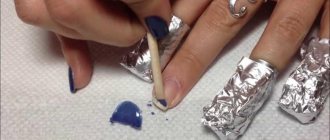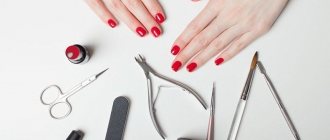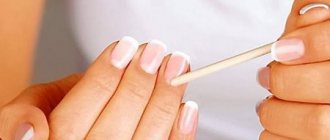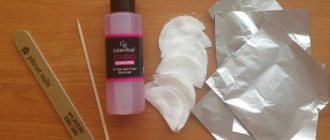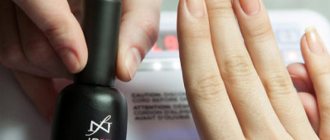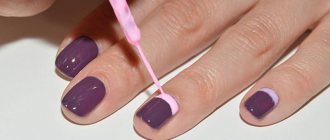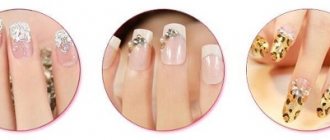Over the past few years, shellac manicure has become one of the most popular beauty procedures, which is included in the list of services of almost every beauty salon. The main advantage of this coating is its durability (up to 4 weeks without chips and cracks), although many experts agree that there are some disadvantages here too. If you consider nail design an important element of your image and at the same time care about the health of your nails, we will tell you what is important to know before a manicure, how to properly remove shellac at home and what procedures to pay attention to in order to minimize its harm.
Photo: unsplash.com
Pros and cons of shellac
In addition to durability, shellac has several other advantages. For example, a varied palette, high color saturation, the ability to remove at home, the absence of toxic substances in the composition, as well as a glossy shine. In addition, some girls use shellac to grow their nails: under a thick layer of coating they do not peel off or break, but the main thing here is not to damage the plate while removing the varnish, otherwise they will have to be filed down and repeated all over again.
The main disadvantage of shellac is that it must be dried under an ultraviolet lamp, the light of which negatively affects the skin, so if you want to protect yourself, apply cream with spf on your hands before going to the salon. Nail polish removers also cause significant harm: they usually contain large quantities of acetone, which greatly dries out the nails, so after this procedure it is important to take time to restore them.
Perfumed mists and mists are the main beauty purchase of the summer
More details
Treatment
What to do when your fingernails come off due to fungus? First of all, you should stop using gel polish for the next 6 months. It is necessary to contact a dermatologist, where a group of medications is prescribed:
- Local antifungal drugs: Terbix Spray; Lotion Candide; Ointments: Lamisil, Mycozan, Exoderil, Mycozoral; Varnishes: Oflomelid, Lotseril, Batrafen.
- Antifungal drugs used orally for systemic action: Itraconazole, Ketoconazole, Terbinafine.
- Mechanical nail removal in an advanced stage.
- General strengthening of the body: balanced nutrition, consumption of lactic acid products, sea fish, fish oil. During therapy, exclude sugar and sweets. Taking vitamin complexes.
Vitamin complex
Why is it not advisable to treat the fungus yourself? People purchase a single-acting drug, but with a mycotic infection, a complex effect on the spores is required for complete elimination. Depending on the type of fungus and the stage of the disease, individual remedies and duration of therapy are selected.
How to remove shellac at home
Photo: unsplash.com
To safely remove shellac at home, you will need:
- nailfile
- cotton pads
- nail polish remover with acetone (it is important that it does not contain care oils)
- foil
- orange wood sticks or metal pusher
- nutritious cream
To begin, cut out small blanks from cotton pads that are shaped like your nails - this is necessary so that the remover does not get on the cuticle and damage it. As much as possible, carefully file away the top layer of shellac - the thinner it is, the faster it will dissolve. Then apply the stencils soaked in nail polish remover to your nails, wrap them tightly with foil and wait 15 minutes. When the timer goes off, carefully remove the foil from your fingers and scrape off any remaining polish with an orange stick. At the end of the procedure, wash your hands and apply nourishing cream to them or make a special moisturizing mask in the form of gloves.
What to do?
If the cause of detachment is injury
In case of incomplete rejection of the nail sheet on the thumb and other fingers in case of mechanical damage, which is not uncommon, the following should be done:
- The affected nail is trimmed daily.
- After which they are treated with a disinfectant.
- The treated area should be covered with a bactericidal patch for the rest of the day.
Surgical methods are used for complete detachment or for a large area of damage . The intervention is carried out by opening the nail bed, removing hyperkeratotic masses, hematomas and the source of contamination.
After surgery, daily dressings are required with mandatory treatment with antibiotics and antiseptics. During the recovery period, solutions with gelatin are used, which have proven to be a very effective remedy.
Microbial damage
Streptococcal or staphylococcal infection
Treatment is carried out using synthomycin gel and heliomycin ointment. Directions for use: treatment of the cuticle and affected area twice a day. Anti-inflammatory drugs are also used in addition to the main treatment.
Effective for local treatment:
- Levomekol ointment;
- preparations based on birch tar;
- Vishnevsky ointment.
Lotions and glycerin dressings are also used.
Candidal mycosis
Basis of therapy: antimicrobial drugs such as:
- “Mikospor” (“Bifonazole”);
- “Loceryl” (varnish is applied once a day);
- “Ketonazole”;
- “Itrazol”, “Itramikol”;
- “Batrafen” (varnish-based ciclopirox).
The use of Exoderil has shown its antifungal effect better than others . The drug is applied to the infected area and nearby areas twice a day.
In severe cases of the disease, antifungal drugs should also be used orally.
Systemic diseases
In this case, onycholysis therapy primarily involves treating the underlying disease that caused the peeling of the nail plates.
Stages of treatment of the disease:
- Vitamin therapy - taking vitamins (C, A, group B, beta-carotene) and microelements (iron, calcium, sulfur, zinc, copper).
- Application of “Solcoseryl” (ointment for external use). The product belongs to the group of biogenic stimulants and activators of metabolism in tissues and has powerful regenerating properties.
- Antihistamines.
- Physiotherapy.
- Nutrition.
If the disease was caused by an allergy or pathology of the digestive system, then it is appropriate to resort to diet therapy.
Can be used as therapy:
- vitamin and mineral complexes;
- antihistamines;
- fish fat;
- Dietary supplements containing amino acids.
Poor nutrition causes slow growth of the nail plate, which leads to its deformation. Patients suffering from onycholysis should include the following nutritional components in the menu :
- gelatin;
- fresh fruits;
- boiled vegetables;
- animal and vegetable proteins;
- nuts, seeds.
Traditional methods of treating nail plate detachment
The main methods consist of taking strengthening baths and lotions.
Here are some recipes:
- Salt bath with potassium permanganate . Dilute a tablespoon of sea salt with hot water and leave for half an hour, then immerse your hands in it. After the bath, wipe your hands dry and apply the medicine.
- Lotion with a paste of oil and garlic . Chopped garlic (5 cloves) is mixed with butter in equal proportions and rubbed into the affected area.
- Iodine . Just apply to your nail plates overnight.
- Propolis is used in the form of night lotions from its infusion.
- Herbal decoction:
- A mixture is prepared from equal proportions of dried oak bark, celandine herb, lilac and calendula flowers.
- The mixture obtained and thoroughly mixed is poured with hot water (temperature about ninety degrees).
- Then the resulting mixture should be placed on the stove and simmered for about ten minutes.
- Then the broth is cooled to room temperature and a twenty-minute therapeutic immersion of the hands is performed.
- Self-massage of fingers . This is done daily. Slowly, gently massage the nails in circular diverging movements in the direction of growth of the nail plate, working more diligently on the fingers with affected nails.
- Gelatin baths . About three grams of gelatin is poured into two hundred milliliters for half an hour. The solution is heated until the gelatin is completely dissolved (without boiling), after which it is cooled. Baths are carried out three times a week.
How to restore healthy nails
Photo: pexels.com
The condition of nails after shellac deteriorates, since shellac itself is a complex chemical compound that, under the influence of ultraviolet light, literally “melts” into the top layer of the nail plate and is removed along with it. Today, many experts agree that it is unsafe to do such a coating all the time; the optimal regime here would be the following formula: two manicures with a durable coating, and then a three-month break, during which you should pay special attention to caring for the health of your nails.
The first thing you should pay attention to in this matter is nutrition. Foods rich in calcium will help restore your nails (and your hair at the same time) - nuts, legumes, seafood, vegetables and leafy greens, which should definitely be included in your diet. Secondly, before applying care products, your nails should be thoroughly polished to remove any remaining varnish and provide oxygen access to them. You can do this at home with a special file. In addition, in the first weeks after removing shellac, it is recommended to carry out all household chores - for example, washing dishes - with gloves to avoid microtraumas.
Mewing - what is it and why is everyone talking about it now?
Read more
In order to restore the health of your nails, twice a day - morning and evening, apply special nourishing oils to them and to the cuticle, always with smooth massage movements. After they are absorbed, your hands can be additionally smeared with cream. Experts do not recommend using folk remedies to treat nails, as they can cause a severe allergic reaction and only worsen the situation. In the modern world, preference should still be given to certified cosmetics - masks, strengtheners and other products, especially since they can be found not only in luxury, but also in mass-market brands.
You can also restore nails after shellac using salon procedures. Here, the most effective are paraffin baths - when a warm composition of heated paraffin is applied to the hands, and “sealing” - when the nail is covered with a viscous product that contains honey and beeswax, which promote intensive nutrition and protection during the recovery period.
Why are nails soft, thin and weakened after gel polish?
Before looking for a solution to the problem, let's consider why nails after gel polish are soft, weakened and thin. Shellac is a kind of hybrid of extension gel and decorative varnish, which, along with their best properties, also incorporates some negative aspects. The coating is made on the basis of natural resins, applied to the polished nail surface and dried by polymerization under a lamp (UV or LED). Considering all of the above, it is not difficult to guess what is damaging the nail plate:
- grinding (before applying the material, the master must file down the top smooth layer of the nails so that the surfaces become slightly rough, and the more the master “overdoes it,” the thinner the plate will become and the longer it will take to restore it);
- after applying shellac to the plate, access to air, sunlight, and nutrients will be blocked (useful components after masks, baths, creams, which are necessary for daily care of hands and nails, will not pass through the material);
- The immediate stage of removing the material is also harmful, namely prolonged exposure to acetone (do not forget that you will have to keep it until the dissolution reaction of the durable, polymerized coating takes place).
As a result: white spots appear on the nails, their structure changes, they become brittle, weak and soft, and until the full recovery process goes through, the nails peel off.
Especially many problems arise for those who use the coating for a long time without taking breaks to give their nails a rest and gain strength. As a result, the plate may have significant deformation and lose the perfectly smooth convex shape inherent in nature. Long-term treatment will be required to restore it.
Vinylux
Despite the fact that vinyllux, which is also called a “weekly coating,” does not stay on the nails for as long as shellac, it does not create the effect of a dense “mask” and does not leave pigment after removal. Vinyllux itself is something between regular varnish and shellac, and its main advantage is that it hardens itself, without the use of a lamp, and quite quickly - in about 10 minutes. In order to remove it, you don’t have to go to the salon either: vinyllux can be easily removed with products that can be bought at any cosmetic store.
Vitamin varnish
Vitamin varnishes, or “strengtheners,” can be used both to restore the structure of the nail after shellac, and simply for prevention. Sometimes, in addition to microelements that accelerate the regeneration process of keratin, which our nails are mainly made of, they contain oils, proteins, silk and Kevlar fibers, which seal microcracks and exfoliated scales. The only disadvantage of such coatings is the meager color palette, which is limited to transparent, pink and beige shades, although for the perfect nude this is exactly what you need!
Varnish film
Along with multi-colored stickers, which were at the peak of popularity in the early 2000s, film varnishes, which can be either plain or with prints, have also returned to fashion. Of course, in order to make a full-fledged manicure with their help, you will have to put in a lot of effort - cut out squares to fit the size of the nail, warm them under a lamp, smooth them well with an orange stick and carefully remove any residue from the edges. But such a coating will allow air to pass through well, last for about two weeks, and due to the printed prints, it allows you to experiment with rather complex patterns, which can be quite difficult to draw on your own.
Photo: unsplash.com
In general, of course, you shouldn’t be afraid of shellac and deny yourself the pleasure of doing a manicure with a long-lasting coating. In order to preserve the health of your nails as much as possible, it is important to remember only the basic rules: study the composition of the products used by the master, and avoid obvious toxic elements that can cause severe allergies - camphor, formaldehyde resins, toluene, xylene and others. Also, when you get tired of the coating, in no case should you just scrape it off your nails, otherwise you can seriously damage their top keratin layer. It’s better to spend a little more time on this procedure, and then give your nails a few days to recover - and then you’ll be fine with them. everything will be all right.
